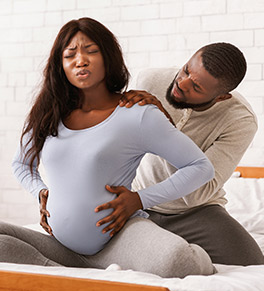Acupressure helps ease the pain of childbirth

"Getting just the right touch at the right time and place can be like a dance between the labor partner and the mother,” UCI Health acupuncturist Heather Rice, says of acupressure.
As many women seek a more natural childbirth experience, some are turning to acupressure to help ease the pain of labor and delivery.
This Chinese massage therapy developed at least 2,000 years ago was designed — like acupuncture, which was introduced later — to encourage the body’s energy, or qi, to flow freely, preventing blockages that can cause pain.
UCI Health experts are teaching expectant mothers and their partners how to use acupressure to alleviate pain and shorten labor. Research shows that these techniques also can help with a host of postpartum issues, including breastfeeding, constipation and depression.
“I use the example of tight shoulder muscles to explain how it works," says UCI Health acupuncturist Heather Rice, LAc, who helped create and now teaches the monthly classes offered online by the Susan Samueli Integrative Health Institute.
"If you apply hands, fingertips or a hot rock, the muscles relax.”
Noninvasive pain control
The pain experienced during the birthing process can be intense for many women. Fear and muscle tension can make it worse.
Several research studies show that acupressure can reduce the perception of pain, lower anxiety and even shorten labor, says Dr. Donna G. Baick, a UCI Health gynecologist and obstetrician.
“Women who have good pain control tend to progress a little bit faster, decreasing the duration of active labor, the risk of C-section and the need for drugs to induce labor and control pain,” says Baick, who is also an associate professor of obstetrics and gynecology at the UCI School of Medicine.
“With acupressure, patients feel they have a lot of control and that increases satisfaction.”
Finding the pressure points
Acupressure techniques also give birth partners an active role in giving comfort and support to women in labor.
“Getting just the right touch at the right time and place can be like a dance between the labor partner and the mother,” Rice says. “It’s noninvasive and allows the mother to move around and use devices such as a birthing ball, which isn’t possible once medication or an epidural is started.”
During the classes, Rice teaches expectant moms and their partners to apply pressure — using fingers, hands, elbows or a massage tool — to key places along the body.
The primary stimulation points are the shoulders, hands, legs and lower back — or sacrum area. Pressure is applied for 30 seconds to two minutes.
“You need to stay with the point for a little while to activate the flow of energy in the body,” Rice says.
A tool for before and after birth
Mothers need not wait until they’re in active labor to benefit from acupressure. Baick suggests starting when the pregnancy reaches full term and mild contractions may have started.
At this stage, applying a gentler touch than would be used during active labor is best, Rice says. This can keep the expectant mother comfortable at home before active labor begins and it’s time to go to the hospital.
Baick emphasizes that acupressure is a complementary therapy that can be used throughout labor and delivery and augmented with medication for pain control as needed.
After the birth, she says, it also can help alleviate cramping and breast pain, stimulate milk production and decrease postpartum depression.
“It’s a wonderful option," Baick says. "I recommend it to all my pregnant and postpartum patients."
Explore further
Browse more blog posts by topic.




